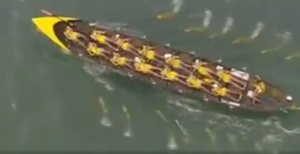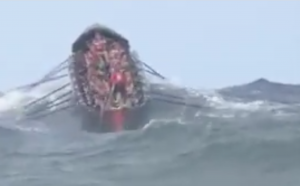Coastal Rowing with John Wik of US Rowing
How did you get interested in Coastal Rowing?
WIK: In 2014 I was on the Board of the Delaware Museum of Natural History. We were trying to figure out why attendance by middle school students was down. It occurred to me that young people today don’t go to museums to look at stuffed animals to learn about natural history, they go on-line.
So I decided to create an on-line program that focused on the Natural History, Cultural History, and Geologic History of the Delmarva Peninsula. Nine months later, with funding from DuPont, NRG, and Valero Oil, the camera / production team and I had built a series of educational videos describing the history of Delmarva. But, I needed a hook to capture the imagination of the young audience I was after. I decided to row a small boat around the Peninsula, outfit with cameras and computers to connect directly to the kids in the class room and bring them along on the Delmarva Odyssey. Four and a half months and 384 miles later, I was hooked on coastal rowing.
What makes coastal rowing different from flat water rowing?
WIK: On the equipment side, Coastal Rowing uses heavy boats designed to handle significant waves, current and wind. Instead of a straight buoyed 2 Km course, coastal races requires the athlete to round buoys following courses that vary in length from short sprints of 500 m to long races of 4 Km to 8 Km. Some events, like the Blackburn Challenge in Boston are 20+ miles. Competitors must be able to adapt to changing wind, tide, and current as they navigate the race course, taking the best line while avoiding other boats. Waves are both a challenge and asset, allowing the athlete to either surf ahead of the competition, or broach and swamp.
Unlike flat water rowing, Coastal boats are limited to singles (C1X), doubles (C2X), and quads with cox’n (C4X). All boats require life jackets and a towing line during racing. Crews, with the exception of the cox’n are not required to wear life jackets, but they must be on board.
What will a flat water rower recognize in the sport?
Despite the differences, flat water racing and coastal racing have some common background. Both flat water and coastal competitors are driven to master the boat, the water and the competition. While the boats and equipment are drastically different, the mechanics are the same. Oars are set on a fulcrum pivot, squared at the catch, drawn through the water, and feathered at the release. The sliding seat found on both the fine boat and coastal boat allows for the traditional legs, back, arms motion.
But, in reality the similarity ends here. Forget keeping your hands one atop the other as you pull equally through the drive. With waves on one side of the boat and a trough on the other, your hands can be way apart. The drive is seldom smooth and the catch to port and starboard in waves is almost never simultaneous. The coastal race course does not provide each crew its own lane and water. It is common for boats to clash oars and even crash into one another, particularly as they round buoys.
There are several aspects to Coastal racing. Beyond FISA class boats there are a wide range of single and team open water boats. Fixed seat, sliding seat, singles, doubles, quads, life guard surf boat competitions all the way up to the big boats races of the Traineras, Basque Country. It is all very exciting for the spectator and more exciting for the athlete. 

https://m.facebook.com/562829414/posts/10156866669499415?s=1171956506&sfns=mo
When did this aspect of the sport of rowing begin in the USA?
Interestingly there have been Coastal Races and Coastal Rowing clubs around for years. Clubs and races have been held in the Northwest, Southeast, Gulf Coast and Northeast. The members of these clubs have come to the Coastal Rowing world through traditional rowing programs as well as life guard surf boat programs, dory and gig rowing programs, and recreational open water rowing programs.
USRowing initiated a small Coastal Rowing effort in 2014, hosting the first International Coastal event in Pensacola Florida. The event was small, drawing only 35 – 40 athletes from several countries, but successful. USRowing pulled back on this initial effort until mid- 2018 when the International Olympic Committee began to discuss removing Light Wt. rowing as an Olympic sport and FISA began to push Coastal Rowing as its replacement. Coastal Rowing is already a major part of the rowing world in Europe, Asia, and South America. With this level of World Wide interest, and the Olympic games scheduled for Los Angeles in 2028, it became clear that Coastal Rowing was the future.
How popular is Coastal Rowing in the US? Is the sport growing?
WIK: We do not have good data on the number of Coastal Rowing participants. There are large pockets and clubs of coastal rowers in the New England, Florida, New Jersey, Seattle, and San Diego areas. Several races are run each year which are growing in popularity. There is strong interest in developing additional Coastal Programs around the Great Lakes. However, many members of the coastal Rowing community do not currently race. They enjoy recreational outings or workouts along the coast.
With the assistance of USRowing, in 2018 a National Coastal Rowing Committee was formed to develop the sport of Coastal Rowing. The Committee has provided guidance in the planning and development of several Coastal Racing events for 2019. These events will focus on the use of FISA design coastal racing boats and equipment. To date the biggest hurdle the Committee has had to overcome is the limited number of coastal boats available for these races, which meet the FISA design specifications. The races and dates are as follows:
Sarasota, FL November 20 – 14, 2019
San Francisco, CA October 5 & 6, 2019
Norwalk, Connecticut September 14 & 15, 2019
With the announcement of the races and articles by USRowing on Coastal, the sport is beginning to catch on.
Is coastal rowing something done by specific coastal clubs? Or, is it simply another element of more traditional rowing clubs?
WIK: A few traditional rowing clubs have seen the value of using the stable platform of coastal rowing shells for both instruction and adaptive rowing programs. They have begun to assemble small fleets of these versatile shells for this purpose. The majority of coastal rowing clubs are focused on open water rowing and have developed learn to row, recreational, training and competitive programs specific to the open water or coastal environment.
How do people find more information on Coastal Rowing in their areas?
WIK: Look to the internet. There is a host of information on upcoming races, both here and abroad. Check out the organizing committee or club and contact them. Boat manufactures and distributors, including Lite Boat, Swift and Eurodiffusion, can also help direct and get you started. Information can also be found on Face Book (Coastal Rowing USA and World Rowing Coastal).
What are the costs to get started in Coastal Rowing?
WIK: Depending on the equipment you select, the cost of a coastal shell is pretty comparable to the cost of a traditional racing shell. Coastal quads will generally require a hand trailer, or a lot of people, to launch. While coastal oars are typically a bit shorter than traditional oars, to get started traditional oars are very acceptable.
Is it easy for an existing club to get coastal up and running?
WIK: Traditional rowers are already adept at entering, exiting, and balancing a racing shell. The stable platform provided by the coastal shell makes the transition easy. Coastal boats can be entered from the dock or beach. Given these similarities it is a simple matter for a club to purchase a couple of coastal singles, doubles or quads, field a crew and go have fun either touring or racing.
When where are competitions for Coastal Racing?
WIK: In addition to the races scheduled for the US and listed above, there are several international races. The biggest is the World Championship to be held in Hong Kong, HKG November 1 – 3, 2019. Several US clubs and individuals have already signed up for this event. This is a masters event and open to all. However, you must be ranked by USRowing. If interested contact John Wik, Director of Coastal Rowing, at [email protected].
What is the format for a Coastal Race?
WIK: Unlike traditional racing, Coastal regattas have a wide range of formats. First, there is never a straight course. Coastal regattas are set up much like a sailing regatta. Athletes are expected to navigate to a mark, round the mark, and head to the next mark. Courses can include a simple out and back, a triangle, or other variations. Some coastal events, like the Blackburn Challenge, use points of land.
Typical coastal events include the men’s and women’s C1X; men’s, women’s, and mixed C2X; and men’s, women’s, and mixed C4X.
Starting lines can be between two points on the water, again like a sailboat regatta, or a new format for rowing – the beach start. With the beach start, one athlete from each crew is required to line up on the beach behind the start/finish line. Boats are lined up on the shore and held either by crew (doubles and quads) or an assistant (single). At the start, the athlete runs through the start/finish, jumps into the boat and away you go. At the finish, the boat is beached, the athlete jumps out of the boat and runs back through the start/finish line. Much like the LeMonds start in car racing, the beach start adds a lot of spectator excitement and appeal to the race.
The length of a coastal regatta depends on the course, the number of athletes, and the experience of the crews racing. Sprints of 500 m out and back with a simple one buoy course, 2 Km triangle courses, standard 4 Km to 8 Km courses around multiple buoys, and long distance courses are all acceptable.
Officials follow races, checking to make sure crews properly round marks and do not intentionally imped the progress of another crew. Penalties can include an assessment of additional time, the requirement to re-round a buoy, or if a buoy is missed, exclusion for not properly completing the course.
What does it take to host a Coastal Regatta?
WIK: Unlike traditional rowing, Coastal Regattas do not require access to a buoyed 1000m or 2000m course. A simple open body of water with access for boat launching is about all that is needed. Official and safety launches should always be on hand and the LOC should watch the weather and be aware of any tide or current anomalies that could make the regatta unsafe.
Perhaps the biggest limitation to hosting a Coastal Regatta is the limited number of FISA class coastal boats available. As the sport has been developing the number of boats has increased, but FISA class boats are still limited. Many clubs overcome this limitation by simply allowing any boat to race. A caution here – the LOC and Chief Referee should always evaluate both the condition of the water and the weather before allowing smaller, non-coastal boats, to participate.
One very interesting new twist to the boat availability problem is the “Race In a Box” enclosed trailer developed by Jim Henderson, Sarasota, FL. Jim is a Lite Boat dealer and Chair of the Sarasota Coastal Race scheduled for November. He has recently purchased a 44 foot enclosed trailer with 9 ft of headroom and outfitted the trailer to accommodate 2 quads, 4 doubles, and 8 singles plus all of the equipment needed to host a Coastal Regatta. The trailer and knowledgeable advisors are available for clubs to set up Coastal races.
There has been a definite increase in the interest in Coastal Rowing, with more and more clubs establishing events. The low cost of entry and minimal course requirements make Coastal events very attractive alternative for clubs without easy access to buoyed courses.
Why should rowers try it?
WIK: I may be a bit biased here, but why wouldn’t you? Coastal is a new experience for most rowers. Having a wave crash over your bow as you continue to race, without swamping, is an exhilarating experience. The challenge of navigating a course, understanding the effects of wind, tide and current, as well as the ability to surf the wave to gain position on your competition brings a whole new dimension to the sport of rowing.
Why should non-rowers try it?
WIK: The stable platform provided by the Coastal rowing shell provides a certain level of comfort for the novice. There is an immediate sense of accomplishment in being able to row the coastal shell, without the fear of capsize. This opens the sport of rowing to a number of individuals who would not otherwise feel comfortable getting onto the water. Adaptive athletes also can easily experience the challenge and excitement of rowing using the stable platform of the coastal boat without the need to train with riggers.
Beyond racing, the non-rower can enjoy coastal boating as a recreational rower. The stable platform allows for ease of entry, safety and comfort as the recreational rower tours scenic coasts and vistas. Several touring companies have recognized this and use coastal boats for their tours.
What is USRowing’s plan for Coastal in the short, mid- and long term?
WIK: USRowing continues to develop its plans for Coastal. At present these include providing support to organizations wanting to develop Coastal events or starting a Coastal rowing club or program.
As the International Olympic Committee and FISA firm up their plans for light weight rowing and the potential for including Coastal as an Olympic event, USRowing will focus on the need to develop of a High Performance Coastal Rowing program and team.
